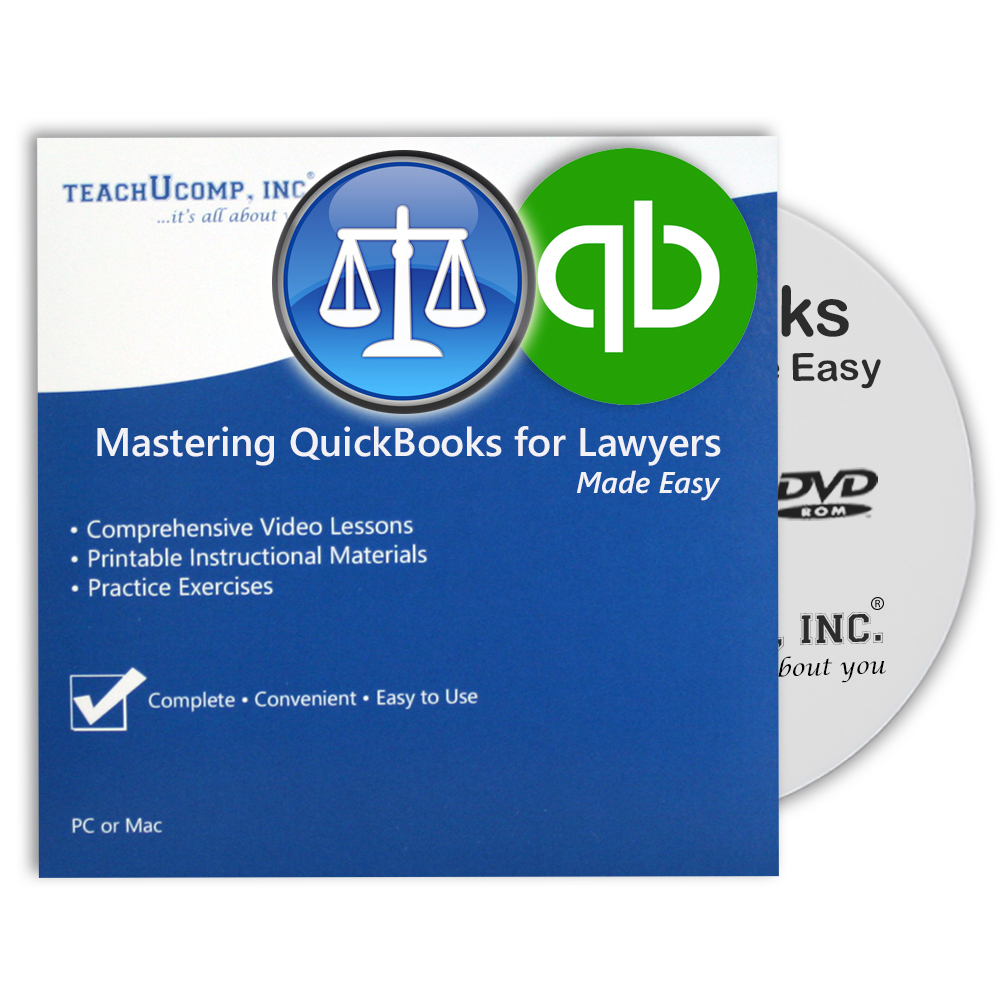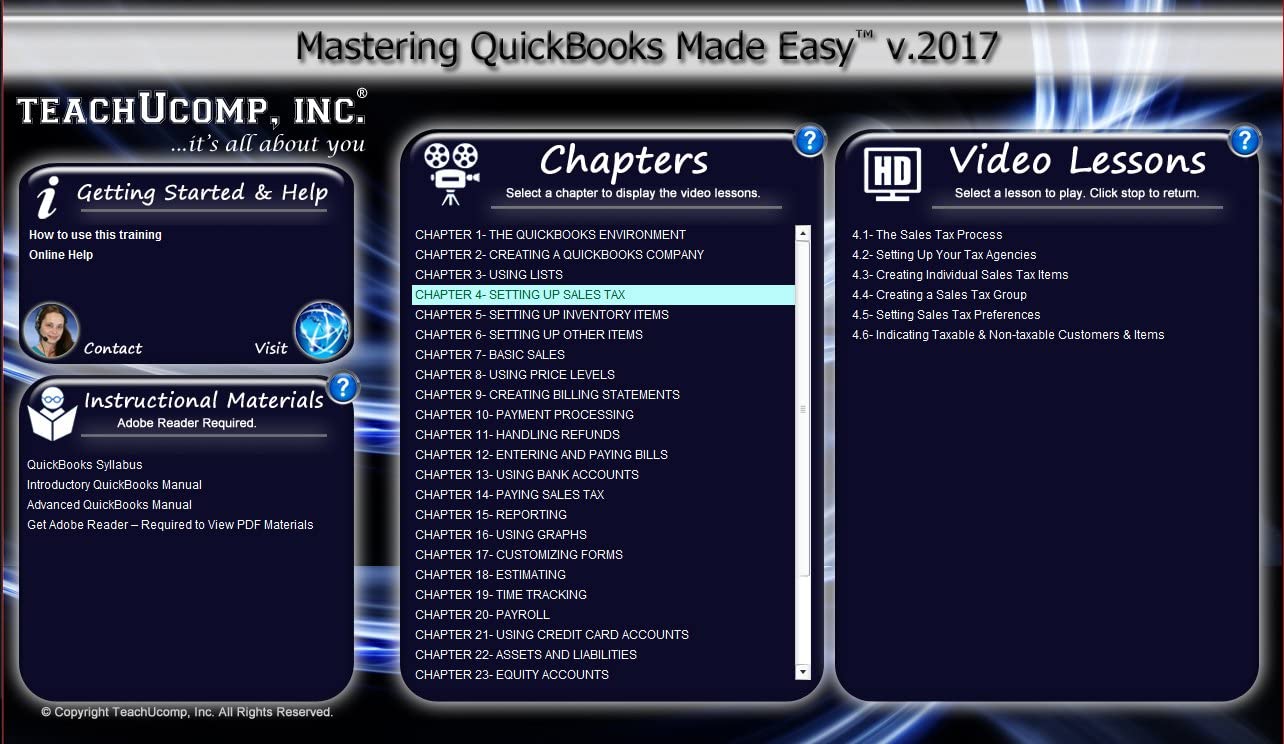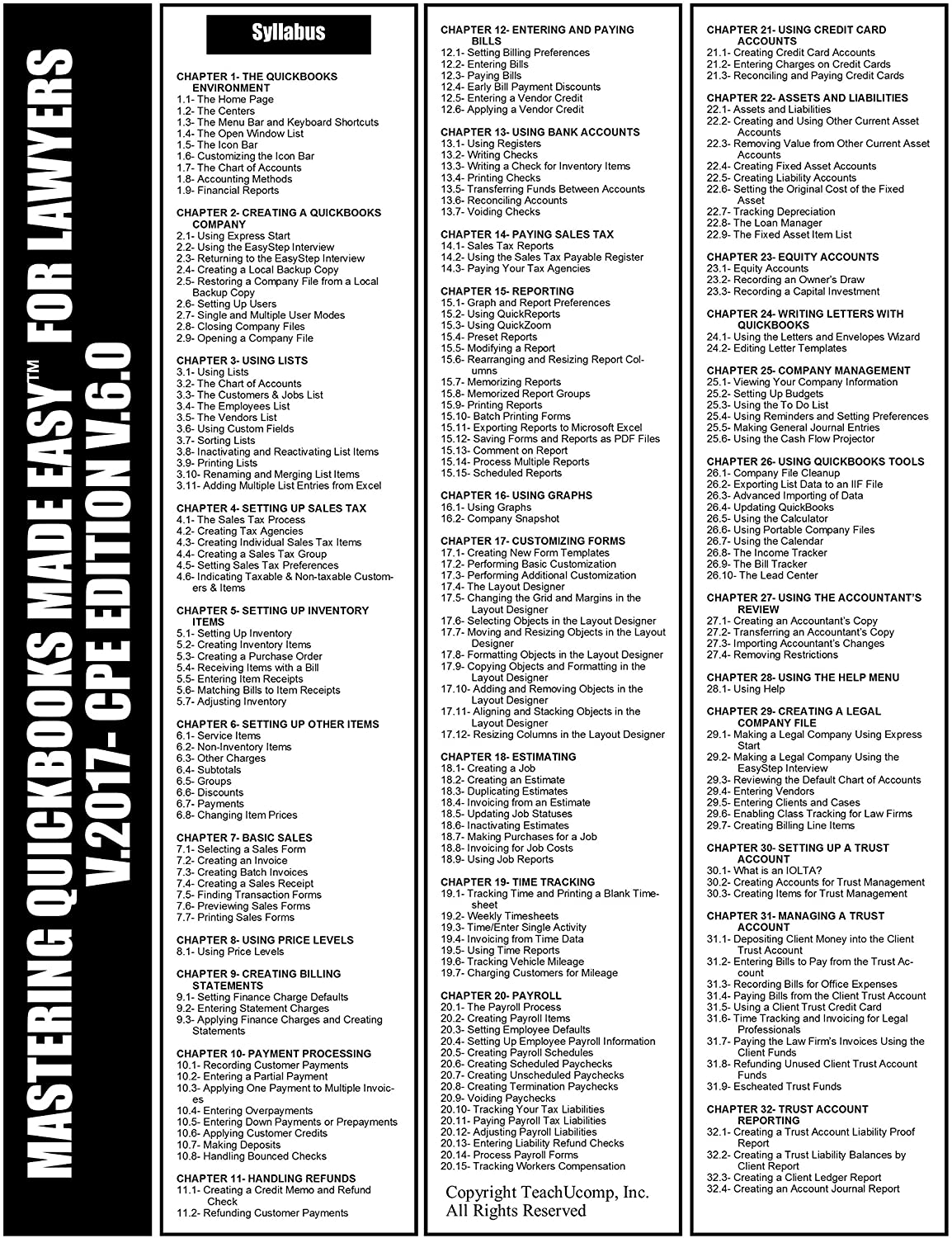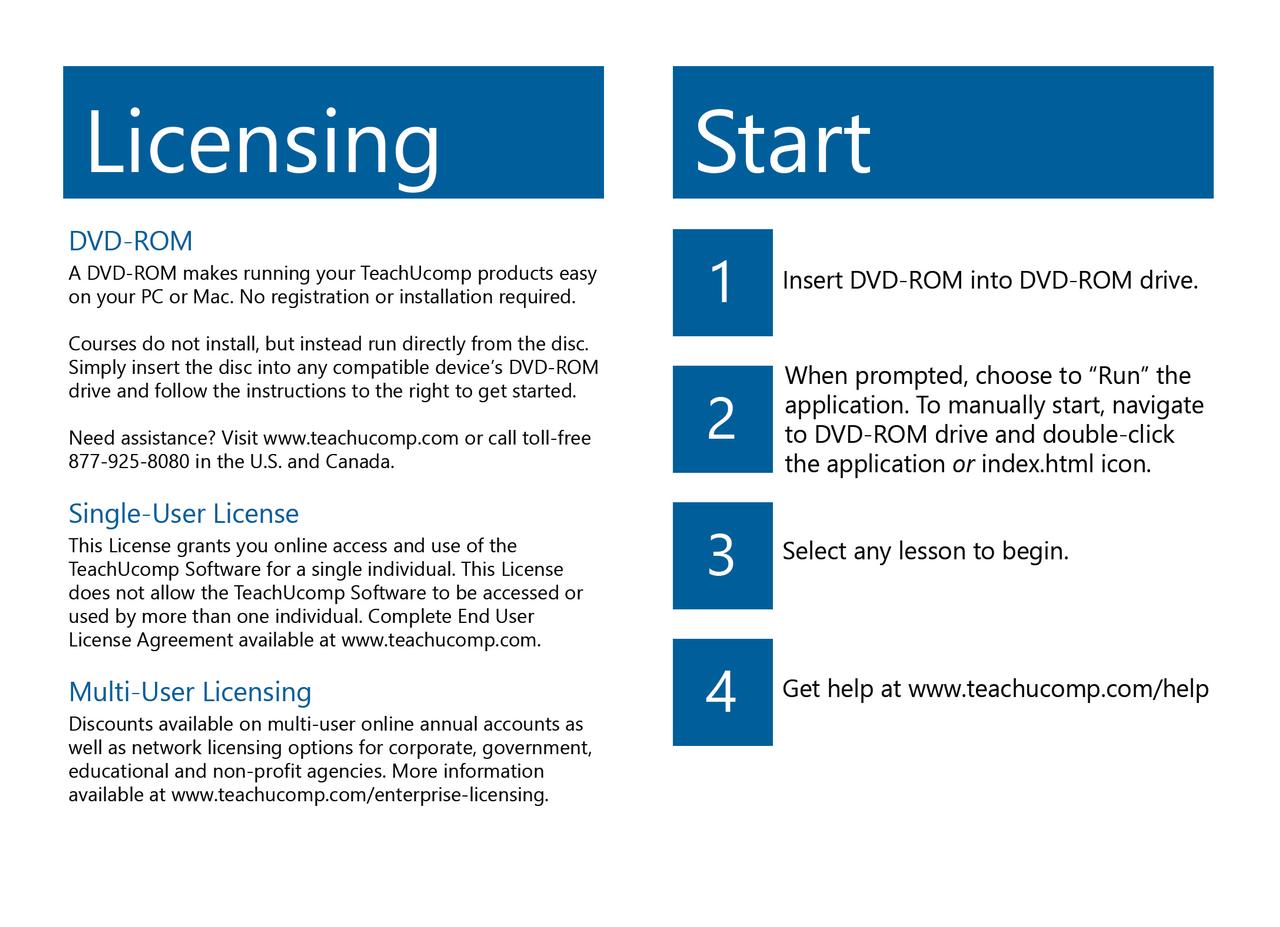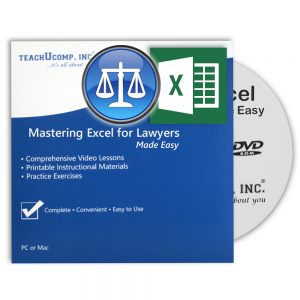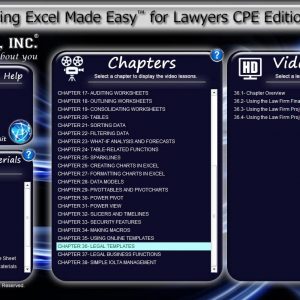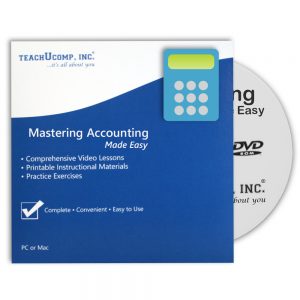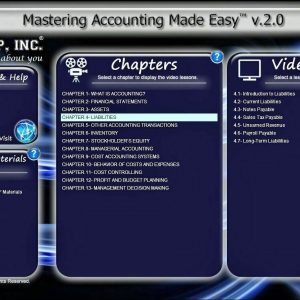Mastering QuickBooks Made Easy for Lawyers v 2017- DVD-ROM
Original price was: $50.00.$25.00Current price is: $25.00.
| Course Title: | Mastering QuickBooks Made Easy for Lawyers |
|---|---|
| Versions Covered: | Pro 2017 |
| Hours of Content: | 1.5 |
| Video Lessons: | 23 |
| Manual: | 347 Pages |
| Includes: | Entire QuickBooks Curriculum (9 hours, 185 lessons, 2 manuals) |
Description
Our complete QuickBooks Pro training course for Lawyers on DVD-ROM. Includes:
- Video Lessons
- Printable Instruction Manuals
- Practice Exam
- Final Exam
- Certificate of Completion
Topics Covered:
The QuickBooks Environment
1. The Home Page
2. The Centers
3. The Menu Bar and Keyboard Shortcuts
4. The Open Window List
5. The Icon Bar
6. Customizing the Icon Bar
7. The Chart of Accounts
8. Accounting Methods
9. Financial Reports
Creating a QuickBooks Company File
1. Using Express Start
2. Using the EasyStep Interview
3. Returning to the Easy Step Interview
4. Creating a Local Backup Copy
5. Restoring a Company File from a Local Backup Copy
6. Setting Up Users
7. Single and Multiple User Modes
8. Closing Company Files
9. Opening a Company File
Using Lists
1. Using Lists
2. The Chart of Accounts
3. The Customers & Jobs List
4. The Employees List
5. The Vendors List
6. Using Custom Fields
7. Sorting List
8. Inactivating and Reactivating List Items
9. Printing Lists
10. Renaming & Merging List Items
11. Adding Multiple List Entries from Excel
Setting Up Sales Tax
1. The Sales Tax Process
2. Creating Tax Agencies
3. Creating Individual Sales Tax Items
4. Creating a Sales Tax Group
5. Setting Sales Tax Preferences
6. Indicating Taxable & Non-taxable Customers and Items
Setting Up Inventory Items
1. Setting Up Inventory
2. Creating Inventory Items
3. Creating a Purchase Order
4. Receiving Items with a Bill
5. Entering Item Receipts
6. Matching Bills to Item Receipts
7. Adjusting Inventory
Setting Up Other Items
1. Service Items
2. Non-Inventory Items
3. Other Charges
4. Subtotals
5. Groups
6. Discounts
7. Payments
8. Changing Item Prices
Basic Sales
1. Selecting a Sales Form
2. Creating an Invoice
3. Creating Batch Invoices
4. Creating a Sales Receipt
5. Finding Transaction Forms
6. Previewing Sales Forms
7. Printing Sales Forms
Using Price Levels
1. Using Price Levels
Creating Billing Statements
1. Setting Finance Charge Defaults
2. Entering Statement Charges
3. Applying Finance Charges and Creating Statements
Payment Processing
1. Recording Customer Payments
2. Entering a Partial Payment
3. Applying One Payment to Multiple Invoices
4. Entering Overpayments
5. Entering Down Payments or Prepayments
6. Applying Customer Credits
7. Making Deposits
8. Handling Bounced Checks
Handling Refunds
1. Creating a Credit Memo and Refund Check
2. Refunding Customer Payments
Entering and Paying Bills
1. Setting Billing Preferences
2. Entering Bills
3. Paying Bills
4. Early Bill Payment Discounts
5. Entering a Vendor Credit
6. Applying a Vendor Credit
Using Bank Accounts
1. Using Registers
2. Writing Checks
3. Writing a Check for Inventory Items
4. Printing Checks
5. Transferring Funds
6. Reconciling Accounts
7. Voiding Checks
Paying Sales Tax
1. Sales Tax Reports
2. Using the Sales Tax Payable Register
3. Paying Your Tax Agencies
Reporting
1. Graph and Report Preferences
2. Using QuickReports
3. Using QuickZoom
4. Preset Reports
5. Modifying a Report
6. Rearranging and Resizing Report Columns
7. Memorizing a Report
8. Memorized Report Groups
9. Printing Reports
10. Batch Printing Forms
11.Exporting Reports to Excel
12. Saving Forms and Reports as PDF Files
13. Comment on a Report
14. Process Multiple Reports
15. Scheduled Reports
Using Graphs
1. Using Graphs
2. Company Snapshot
Customizing Forms
1. Creating New Form Templates
2. Performing Basic Customization
3. Performing Additional Customization
4. The Layout Designer
5. Changing the Grid and Margins in the Layout Designer
6. Selecting Objects in the Layout Designer
7. Moving and Resizing Objects in the Layout Designer
8. Formatting Objects in the Layout Designer
9. Copying Objects and Formatting in the Layout Designer
10. Adding and Removing Objects in the Layout Designer
11. Aligning and Stacking Objects in the Layout Designer
12. Resizing Columns in the Layout Designer
Estimating
1. Creating a Job
2. Creating an Estimate
3. Duplicating Estimates
4. Invoicing From Estimates
5. Updating Job Statuses
6. Inactivating Estimates
7. Making Purchases for a Job
8. Invoicing for Job Costs
9. Using Job Reports
Time Tracking
1. Tracking Time and Printing a Blank Timesheet
2. Weekly Timesheets
3. Time/Enter Single Activity
4. Invoicing from Time Data
5. Using Time Reports
6. Tracking Vehicle Mileage
7. Charging Customers for Mileage
Payroll
1. The Payroll Process
2. Creating Payroll Items
3. Setting Employee Defaults
4. Setting Up Employee Payroll Information
5. Creating Payroll Schedules
6. Creating Scheduled Paychecks
7. Creating Unscheduled Paychecks
8. Creating Termination Paychecks
9. Voiding Paychecks
10. Tracking Your Tax Liabilities
11. Paying Your Payroll Tax Liabilities
12. Adjusting Payroll Liabilities
13. Entering Liability Refund Checks
14. Process Payroll Forms
15. Tracking Workers Compensation
Using Credit Card Accounts
1. Creating Credit Card Accounts
2. Entering Credit Card Charges
3. Reconciling and Paying Credit Cards
Assets and Liabilities
1. Assets and Liabilities
2. Creating and Using an Other Current Asset Account
3. Removing Value from Other Current Asset Accounts
4. Creating Fixed Asset Accounts
5. Creating Liability Accounts
6. Setting the Original Cost of Fixed Assets
7. Tracking Depreciation
8. The Loan Manager
9. The Fixed Asset Item List
Equity Accounts
1. Equity Accounts
2. Recording an Owner’s Draw
3. Recording a Capital Investment
Writing Letters With QuickBooks
1. Using the Letters and Envelopes Wizard
2. Editing Letter Templates
Company Management
1. Viewing Your Company Information
2. Setting Up Budgets
3. Using the To Do List
4. Using Reminders and Setting Preferences
5. Making General Journal Entries
6. Using the Cash Flow Projector
Using QuickBooks Tools
1. Company File Cleanup
2. Exporting List Data to an IIF File
3. Advanced Importing of Data
4. Updating QuickBooks
5. Using the Calculator
6. Using the Portable Company Files
7. Using the Calendar
8. The Income Tracker
9. The Bill Tracker
10. The Lead Center
Using the Accountant’s Review
1. Creating an Accountant’s Copy
2. Transferring an Accountant’s Copy
3. Importing Accountant’s
4. Removing Restrictions
Using the Help Menu
1. Using Help
Creating a Legal Company File
1. Making a Legal Company Using Express Start
2. Making a Legal Company Using the EasyStep Interview
3. Reviewing the Default Chart of Accounts
4. Entering Vendors
5. Entering Clients and Cases
6. Enabling Class Tracking for Law Firms
7. Creating Billing Line Items
Setting up a Trust Account
1. What is an IOLTA?
2. Creating Accounts for Trust Management
3. Creating Items for Trust Management
Managing a Trust Account
1. Depositing Client Money into the Client Trust Account
2. Entering Bills to Pay from the Trust Account
3. Recording Bills for Office Expenses
4. Paying Bills from the Client Trust Account
5. Using a Client Trust Credit Card
6. Time Tracking and Invoicing for Legal Professionals
7. Paying the Law Firm’s Invoices Using the Client Funds
8. Refunding Unused Client Trust Account Funds
9. Escheated Trust Funds
Trust Account Reporting
1. Creating a Trust Account Liability Proof Report
2. Creating a Trust Liability Balances by Client Report
3. Creating a Client Ledger Report
4. Creating an Account Journal Report
Additional information
| Weight | 1 oz |
|---|

